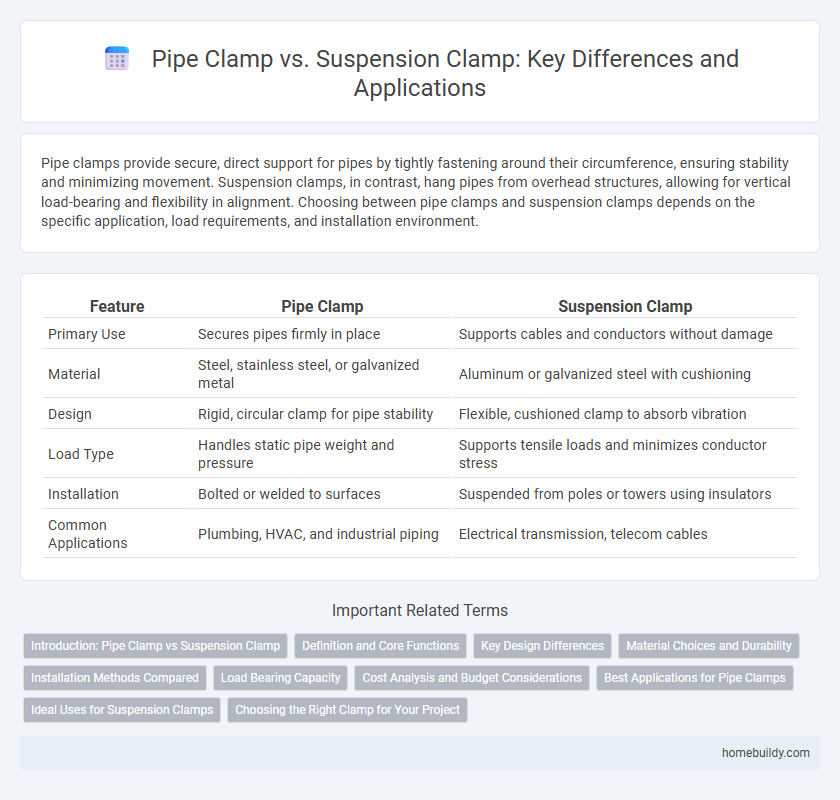Pipe clamps provide secure, direct support for pipes by tightly fastening around their circumference, ensuring stability and minimizing movement. Suspension clamps, in contrast, hang pipes from overhead structures, allowing for vertical load-bearing and flexibility in alignment. Choosing between pipe clamps and suspension clamps depends on the specific application, load requirements, and installation environment.
Table of Comparison
| Feature | Pipe Clamp | Suspension Clamp |
|---|---|---|
| Primary Use | Secures pipes firmly in place | Supports cables and conductors without damage |
| Material | Steel, stainless steel, or galvanized metal | Aluminum or galvanized steel with cushioning |
| Design | Rigid, circular clamp for pipe stability | Flexible, cushioned clamp to absorb vibration |
| Load Type | Handles static pipe weight and pressure | Supports tensile loads and minimizes conductor stress |
| Installation | Bolted or welded to surfaces | Suspended from poles or towers using insulators |
| Common Applications | Plumbing, HVAC, and industrial piping | Electrical transmission, telecom cables |
Introduction: Pipe Clamp vs Suspension Clamp
Pipe clamps secure pipes by providing firm, adjustable support directly around the pipe's circumference, ideal for preventing movement and reducing vibration. Suspension clamps, designed to hang pipes from ceilings or beams, distribute weight evenly and accommodate thermal expansion, making them suitable for overhead installations. Choosing between pipe clamps and suspension clamps depends on application needs such as load type, pipe orientation, and environmental conditions.
Definition and Core Functions
A pipe clamp is a mechanical fastener designed to secure pipes by tightly gripping their outer surface, ensuring stability and preventing movement or vibration. Suspension clamps support pipes by hanging them from structures, providing load-bearing capacity and accommodating thermal expansion. While pipe clamps primarily focus on immobilizing and securing pipes, suspension clamps are engineered to carry the pipe's weight and allow controlled movement.
Key Design Differences
Pipe clamps provide firm radial support by encircling pipes with a tight grip, ideal for preventing lateral movement and ensuring secure placement along straight pipe runs. Suspension clamps, designed to hang pipes from overhead structures, use flexible gripping mechanisms that accommodate axial expansion and contraction while maintaining vertical support. Key design differences involve load-bearing orientation--pipe clamps focus on horizontal stabilization, whereas suspension clamps handle vertical load with allowances for thermal movement.
Material Choices and Durability
Pipe clamps are typically made from stainless steel or galvanized steel, providing strong resistance against corrosion and mechanical stress, making them ideal for securing pipes in harsh environments. Suspension clamps, often composed of aluminum alloy or galvanized steel, offer lightweight yet durable support, especially effective in overhead or suspended applications where vibration dampening is needed. The choice between these clamps hinges on specific material properties and durability requirements, with pipe clamps excelling in rigidity and suspension clamps optimized for flexibility and load distribution.
Installation Methods Compared
Pipe clamps are installed by securely fastening around the pipe's outer surface using bolts or screws, providing a rigid and stable support ideal for horizontal or vertical pipe runs. Suspension clamps, by contrast, are designed to hang pipes by gripping their circumference with a cushioning insert, typically installed using hangers or rods from overhead structures. This method reduces stress and allows for slight movement, making suspension clamps suitable for overhead piping systems where flexibility and vibration absorption are critical.
Load Bearing Capacity
Pipe clamps typically offer higher load-bearing capacity compared to suspension clamps, making them suitable for supporting heavy pipes in industrial applications. Suspension clamps are designed primarily to hold pipes with minimal load, focusing on flexibility and vibration absorption rather than maximum weight support. Selecting a pipe clamp or suspension clamp depends on the specific load requirements and the mechanical stresses involved in the piping system.
Cost Analysis and Budget Considerations
Pipe clamps generally offer a lower upfront cost compared to suspension clamps, making them a preferred choice for budget-conscious projects involving smaller diameter pipes or lighter loads. Suspension clamps, while more expensive initially due to their complex design and material requirements, provide enhanced durability and load distribution, potentially reducing long-term maintenance costs in heavy-duty or high-stress applications. Considering total cost of ownership, project managers should weigh initial expenses against lifecycle performance to determine the most cost-effective option for their specific infrastructure needs.
Best Applications for Pipe Clamps
Pipe clamps are best suited for securing pipes in plumbing, HVAC, and industrial piping systems where stable, rigid support is required to prevent movement and vibration. They provide tight, durable fastening against walls, ceilings, or beams, ideal for smaller or medium-sized pipes. Suspension clamps, by contrast, are primarily used for hanging pipes from overhead supports, making pipe clamps preferable for horizontal installations demanding firm anchoring and minimal pipe displacement.
Ideal Uses for Suspension Clamps
Suspension clamps are ideal for supporting and securing overhead pipes, especially in long-span installations where minimizing stress and movement is crucial. They effectively absorb vibration and accommodate thermal expansion, making them suitable for pipelines exposed to dynamic loads or temperature fluctuations. Unlike pipe clamps that provide rigid support, suspension clamps enhance pipeline durability by reducing fatigue and preventing structural damage.
Choosing the Right Clamp for Your Project
Selecting the right clamp for your project depends on load requirements and pipe orientation, where pipe clamps provide secure, direct fastening suitable for rigid support and suspension clamps are ideal for bearing tensile loads in suspended applications. Pipe clamps ensure firm attachment around the pipe circumference, preventing movement in horizontal or vertical installations, while suspension clamps distribute weight evenly, minimizing stress on both pipe and support structure. Understanding these functional differences helps optimize durability and safety in pipeline construction and maintenance.
Pipe clamp vs Suspension clamp Infographic

 homebuildy.com
homebuildy.com